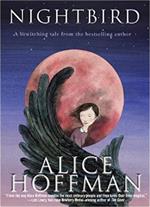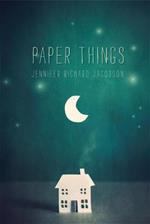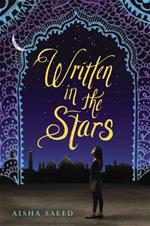Today’s diverse family structures and connections with friends, grandparents, aunts, uncles, and others remind us how intergenerational relationships can enrich our perspectives about the world, often coming to understand ourselves better in the process. The members of the Children’s Literature and Reading Special Interest Group present here selections that will promote conversations to celebrate the beauty and joy of multiage families.
Ages 4–8
Here She Is! Catherine Leblanc and Eve Tharlet. 2015. Minieditions.
 Little Bear cannot wait for the arrival of his new sister. However, once little Anna comes home, he is not impressed by all the fuss and attention. He cannot understand Mother and Father Bear’s excitement over her soft fur or gurgling. Little Bear’s initial jealousy subsides after he decides to spend some time with Little Anna. One beaming smile, meant just for him, changes his outlook, and he decides there is room in the family for both little bears. Little Bear solves the problem, and the message of acceptance and love abounds in the text and illustrations. The beautiful illustrations showcase the various emotions and expressions felt by members of a growing family.
Little Bear cannot wait for the arrival of his new sister. However, once little Anna comes home, he is not impressed by all the fuss and attention. He cannot understand Mother and Father Bear’s excitement over her soft fur or gurgling. Little Bear’s initial jealousy subsides after he decides to spend some time with Little Anna. One beaming smile, meant just for him, changes his outlook, and he decides there is room in the family for both little bears. Little Bear solves the problem, and the message of acceptance and love abounds in the text and illustrations. The beautiful illustrations showcase the various emotions and expressions felt by members of a growing family.
—MN
In a Village by the Sea. Muon Van. 2015. Ill. A. Chu. Creston.
 In this beautifully illustrated story, the simple text allows the reader to focus truly on the powerful images and illustrative scenes. The story begins with a wife and child anxiously awaiting the return of the fisherman/husband (father). The looming storm and dark clouds cause concern. Will he get home safe? There are many visual treasures in this book, including the repeated appearance of the family dog and the clever foreshadowing of the “artist in residence,” a brown cricket, living beneath the wooden floor. This book promotes opportunities to foster language development and critical viewing.
In this beautifully illustrated story, the simple text allows the reader to focus truly on the powerful images and illustrative scenes. The story begins with a wife and child anxiously awaiting the return of the fisherman/husband (father). The looming storm and dark clouds cause concern. Will he get home safe? There are many visual treasures in this book, including the repeated appearance of the family dog and the clever foreshadowing of the “artist in residence,” a brown cricket, living beneath the wooden floor. This book promotes opportunities to foster language development and critical viewing.
—MN
The New Small Person. Lauren Child. 2015. Candlewick.
 A new sibling always requires some adjustment. In the case of Elmer Green, the “small person” welcomed into his family seems to have no regard for his property or ways of doing things. He licks his jelly beans, wears his costumes, and eventually moves into Elmer’s room. Throughout the conflicts in the story, the younger sibling remains a “small person.” The two siblings eventually connect, thanks to a bad dream, a long line of things, and silly TV. Finally, Albert and Elmer are able to share jelly beans, conditionally at least! The playful illustrations, clever text design and placement, and carefully paced plot all help to convey Albert’s experience of embracing the expansion of his family.
A new sibling always requires some adjustment. In the case of Elmer Green, the “small person” welcomed into his family seems to have no regard for his property or ways of doing things. He licks his jelly beans, wears his costumes, and eventually moves into Elmer’s room. Throughout the conflicts in the story, the younger sibling remains a “small person.” The two siblings eventually connect, thanks to a bad dream, a long line of things, and silly TV. Finally, Albert and Elmer are able to share jelly beans, conditionally at least! The playful illustrations, clever text design and placement, and carefully paced plot all help to convey Albert’s experience of embracing the expansion of his family.
—LC
Ages 9–11
Half a Man. Michael Morpurgo. 2015. Candlewick.
 In just 50 pages, the narrator of this book shares his relationship with his grandfather. The story is complemented by both small and full-page illustrations that powerfully set the tone of the story. The book starts with an explanation of how the young boy, Michael, reacts to his grandfather’s scarred face. His grandfather, a British WWII veteran, was on his third trip in a merchant navy convoy when the ship was torpedoed. Halfway through the book, when his grandfather describes the torpedo strike, the story is interspersed with three wordless spreads. One shows the convoy heading out fishing in a small boat, the white sky meeting pale blue water. Another is red, orange, and black as the two men struggle through the flames and water. The third captures the perspective as the men in the lifeboat look up to see a huge destroyer come to their rescue. Although this may be the climax of the story, it’s the connection between the boy and his grandfather that readers will remember. The matter-of-fact tone of the narration balances the intensity of the events in the story.
In just 50 pages, the narrator of this book shares his relationship with his grandfather. The story is complemented by both small and full-page illustrations that powerfully set the tone of the story. The book starts with an explanation of how the young boy, Michael, reacts to his grandfather’s scarred face. His grandfather, a British WWII veteran, was on his third trip in a merchant navy convoy when the ship was torpedoed. Halfway through the book, when his grandfather describes the torpedo strike, the story is interspersed with three wordless spreads. One shows the convoy heading out fishing in a small boat, the white sky meeting pale blue water. Another is red, orange, and black as the two men struggle through the flames and water. The third captures the perspective as the men in the lifeboat look up to see a huge destroyer come to their rescue. Although this may be the climax of the story, it’s the connection between the boy and his grandfather that readers will remember. The matter-of-fact tone of the narration balances the intensity of the events in the story.
—LC
Nightbird. Alice Hoffman. 2015. Wendy Lamb.
 This fantastical story is driven by setting and layered with mystery. The endpapers introduce a blue-toned scene full of information and hints about the story. A pink moon is setting, the orchard is in bloom, and several characters are visible, if you look closely. The small town of Sidwell is home to Twig and her mother, the town baker. They live a quiet and isolated life on the orchard. There are lots of reasons for their isolation: an estranged father, a brother with wings, and a family curse. When new neighbors move in, Twig’s family is no longer able to keep their secrets under wraps. Twig’s voice and perspective resonate, and the portrayal of the nature of this community is beautifully embedded, but some aspects of how the plot is revealed feels uneven. Suspension of disbelief will be easy for readers who are drawn to the fantasy elements related to witches, curses, and wings.
This fantastical story is driven by setting and layered with mystery. The endpapers introduce a blue-toned scene full of information and hints about the story. A pink moon is setting, the orchard is in bloom, and several characters are visible, if you look closely. The small town of Sidwell is home to Twig and her mother, the town baker. They live a quiet and isolated life on the orchard. There are lots of reasons for their isolation: an estranged father, a brother with wings, and a family curse. When new neighbors move in, Twig’s family is no longer able to keep their secrets under wraps. Twig’s voice and perspective resonate, and the portrayal of the nature of this community is beautifully embedded, but some aspects of how the plot is revealed feels uneven. Suspension of disbelief will be easy for readers who are drawn to the fantasy elements related to witches, curses, and wings.
—LC
Ages 12–14
Paper Things. Jennifer Richard Jacobson. 2014. Candlewick.
 When Arianna (“Ari”) Hazard’s parents died, her guardian Janna decided to look after her and her older brother Gage. Janna was a very good friend of Ariana’s mother, who wanted to ensure that her hopes and dreams for her children would come to fruition. Unfortunately, the relationship between Gage and Janna was tenuous, especially as he entered adulthood. When Gage decides to move out with his 11-year-old sister Ari, he lies to Janna about having a place of his own. Ari struggles to maintain a sense of normalcy at school despite the constant transitions of moving into their car, homeless shelters, and friends’ homes. She brings with her few belongings, including her “paper things”—people and furniture cut from catalogs. The paper things reflect her sense of loss as well as her hope for a better tomorrow. Ari’s resilience and positive outlook, given her situation, led her to make new friends and “shine wherever she went.” Jacobson’s realistic fiction novel provides a rich context for dialogue about recognizing the signs of homelessness and providing resources to students and families.
When Arianna (“Ari”) Hazard’s parents died, her guardian Janna decided to look after her and her older brother Gage. Janna was a very good friend of Ariana’s mother, who wanted to ensure that her hopes and dreams for her children would come to fruition. Unfortunately, the relationship between Gage and Janna was tenuous, especially as he entered adulthood. When Gage decides to move out with his 11-year-old sister Ari, he lies to Janna about having a place of his own. Ari struggles to maintain a sense of normalcy at school despite the constant transitions of moving into their car, homeless shelters, and friends’ homes. She brings with her few belongings, including her “paper things”—people and furniture cut from catalogs. The paper things reflect her sense of loss as well as her hope for a better tomorrow. Ari’s resilience and positive outlook, given her situation, led her to make new friends and “shine wherever she went.” Jacobson’s realistic fiction novel provides a rich context for dialogue about recognizing the signs of homelessness and providing resources to students and families.
—MN
Ages 15+
The Tightrope Walkers. David Almond. 2015. Candlewick.
 For Dominic (“Dom”) Hall, reality is the shipyards where his father works, but that’s also a reality he’d like to transcend. Set in Northern England in the 1960s, time and place are integral to the story. Although Dom is the main character, Holly and Vincent are powerful players in his journey. The friendship he shares with Holly is the brightest element in the novel. She is artistic and eccentric in the best ways, enabling Dom to see opportunities he may never have noticed. One of these opportunities is tightrope walking. After seeing a tightrope act at the circus, Holly convinces him to try it, saying, “We’re light, we’re strong, and we’re young.” Vincent’s influence is not as positive or pleasant as that of Holly’s, and he takes Dom and readers into dark territory. Almond invites readers into the hearts and minds of these characters through authentic dialogue and rich description. This is a haunting tale of the kind of conflict and tension that is just right for young adults.
For Dominic (“Dom”) Hall, reality is the shipyards where his father works, but that’s also a reality he’d like to transcend. Set in Northern England in the 1960s, time and place are integral to the story. Although Dom is the main character, Holly and Vincent are powerful players in his journey. The friendship he shares with Holly is the brightest element in the novel. She is artistic and eccentric in the best ways, enabling Dom to see opportunities he may never have noticed. One of these opportunities is tightrope walking. After seeing a tightrope act at the circus, Holly convinces him to try it, saying, “We’re light, we’re strong, and we’re young.” Vincent’s influence is not as positive or pleasant as that of Holly’s, and he takes Dom and readers into dark territory. Almond invites readers into the hearts and minds of these characters through authentic dialogue and rich description. This is a haunting tale of the kind of conflict and tension that is just right for young adults.
—LC
Written in the Stars. Aisha Saeed. 2015. Nancy Paulsen.
 In this compelling and poignant novel, 17-year-old Naila is caught between two cultures. Her Pakistani immigrant parents have very strict rules and expectations of girls. When Naila sneaks off to attend her school prom with her Pakistani American boyfriend Saif, her parents show up and take her home. Soon after, her family brings her to Pakistan in an effort to reintroduce her culture and to reinforce customs, including a forced marriage. Naila attempts to escape and contact her true love, Saif, but is unable to do so. Eventually, a husband is chosen for her, and Naila struggles to navigate the realities of her circumstances. Naila admits to her husband that she is unhappy. Naila wonders, “How can this be a marriage? I am here against my will. He is not my husband. He’s someone I must endure.” Eventually, Naila returns to the United States with Saif despite the shame and embarrassment that she brought to her family. This adolescent novel sheds light on the reality of forced marriages on young women. The back matter includes a glossary, an author’s note, and helpful resources.
In this compelling and poignant novel, 17-year-old Naila is caught between two cultures. Her Pakistani immigrant parents have very strict rules and expectations of girls. When Naila sneaks off to attend her school prom with her Pakistani American boyfriend Saif, her parents show up and take her home. Soon after, her family brings her to Pakistan in an effort to reintroduce her culture and to reinforce customs, including a forced marriage. Naila attempts to escape and contact her true love, Saif, but is unable to do so. Eventually, a husband is chosen for her, and Naila struggles to navigate the realities of her circumstances. Naila admits to her husband that she is unhappy. Naila wonders, “How can this be a marriage? I am here against my will. He is not my husband. He’s someone I must endure.” Eventually, Naila returns to the United States with Saif despite the shame and embarrassment that she brought to her family. This adolescent novel sheds light on the reality of forced marriages on young women. The back matter includes a glossary, an author’s note, and helpful resources.
—MN
Lesley Colabucci is an associate professor at Millersville University in Pennsylvania where she teaches courses in children’s/adolescent literature. Mary Napoli is an associate professor of reading at Penn State Harrisburg where she teaches literacy courses.
The review contributions are provided by members of the International Literacy Association’s Children’s Literature and Reading Special Interest Group.